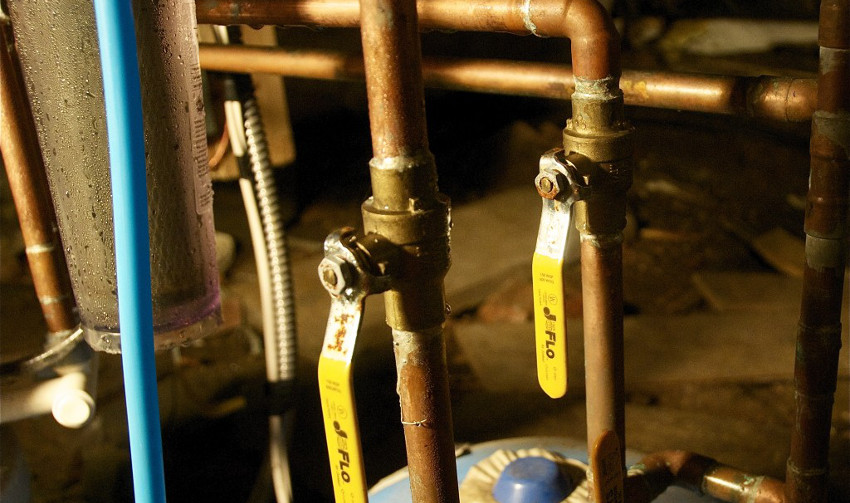Identifying As Well As Fixing Plumbing Sounds In Your Home
Identifying As Well As Fixing Plumbing Sounds In Your Home
Blog Article
They are making a few great annotation on the subject of Why Do My Plumbing Pipes Make A Knocking Noise as a whole in this post down below.

To detect noisy plumbing, it is very important to figure out very first whether the undesirable noises take place on the system's inlet side-in various other words, when water is transformed on-or on the drain side. Noises on the inlet side have varied causes: extreme water pressure, worn valve as well as tap components, poorly attached pumps or various other devices, inaccurately positioned pipe fasteners, and plumbing runs containing too many tight bends or other restrictions. Noises on the drain side usually stem from poor location or, as with some inlet side noise, a layout containing tight bends.
Hissing
Hissing noise that occurs when a faucet is opened slightly normally signals extreme water pressure. Consult your regional water company if you think this problem; it will be able to tell you the water pressure in your area and also can mount a pressurereducing shutoff on the inbound supply of water pipe if necessary.
Various Other Inlet Side Noises
Squeaking, squealing, scraping, snapping, and also touching normally are triggered by the expansion or contraction of pipelines, normally copper ones providing hot water. The sounds take place as the pipelines slide against loose fasteners or strike neighboring home framing. You can frequently determine the place of the issue if the pipes are revealed; simply comply with the sound when the pipelines are making sounds. Probably you will uncover a loosened pipe wall mount or a location where pipes exist so near floor joists or other mounting pieces that they clatter against them. Affixing foam pipeline insulation around the pipes at the point of call must fix the problem. Make sure straps and also hangers are secure and also offer adequate support. Where feasible, pipe bolts must be attached to substantial structural components such as foundation walls rather than to framing; doing so decreases the transmission of vibrations from plumbing to surface areas that can magnify and move them. If attaching bolts to framing is inescapable, wrap pipelines with insulation or other durable material where they contact fasteners, and also sandwich the ends of brand-new fasteners in between rubber washers when mounting them.
Fixing plumbing runs that experience flow-restricting tight or many bends is a last resort that must be undertaken just after getting in touch with a competent plumbing service provider. Sadly, this situation is relatively usual in older homes that might not have been constructed with indoor plumbing or that have seen numerous remodels, especially by novices.
Babbling or Screeching
Extreme chattering or shrilling that occurs when a shutoff or tap is turned on, which generally disappears when the fitting is opened totally, signals loose or faulty inner components. The solution is to replace the shutoff or tap with a brand-new one.
Pumps and home appliances such as cleaning equipments and dishwashing machines can move electric motor noise to pipes if they are incorrectly attached. Connect such items to plumbing with plastic or rubber hoses-never stiff pipe-to isolate them.
Drain Sound
On the drainpipe side of plumbing, the chief goals are to get rid of surface areas that can be struck by dropping or hurrying water and to insulate pipes to consist of inescapable audios.
In new construction, tubs, shower stalls, bathrooms, and also wallmounted sinks and also containers should be set on or against durable underlayments to decrease the transmission of noise via them. Water-saving commodes and also taps are less noisy than conventional models; install them rather than older types even if codes in your area still permit utilizing older components.
Drains that do not run up and down to the cellar or that branch right into straight pipeline runs sustained at flooring joists or various other mounting existing specifically frustrating sound troubles. Such pipelines are large enough to emit substantial resonance; they additionally lug substantial quantities of water, that makes the scenario even worse. In brand-new building, specify cast-iron soil pipes (the large pipes that drain toilets) if you can manage them. Their enormity has a lot of the sound made by water going through them. Likewise, avoid routing drainpipes in wall surfaces shown to bed rooms as well as spaces where people gather. Wall surfaces having drains must be soundproofed as was explained earlier, using dual panels of sound-insulating fiber board as well as wallboard. Pipes themselves can be wrapped with unique fiberglass insulation created the function; such pipes have an impervious plastic skin (often consisting of lead). Results are not constantly sufficient.
Thudding
Thudding sound, typically accompanied by trembling pipes, when a tap or home appliance valve is switched off is a problem called water hammer. The noise and resonance are triggered by the reverberating wave of stress in the water, which unexpectedly has no location to go. Sometimes opening up a valve that discharges water promptly into a section of piping consisting of a limitation, elbow, or tee installation can create the very same problem.
Water hammer can typically be healed by setting up fittings called air chambers or shock absorbers in the plumbing to which the problem shutoffs or faucets are attached. These gadgets allow the shock wave developed by the halted flow of water to dissipate airborne they include, which (unlike water) is compressible.
Older plumbing systems may have brief vertical areas of capped pipe behind wall surfaces on faucet competes the exact same objective; these can ultimately loaded with water, minimizing or destroying their efficiency. The cure is to drain pipes the water system entirely by shutting off the major supply of water shutoff and opening up all faucets. After that open the primary supply valve as well as shut the faucets individually, starting with the tap nearest the valve as well as finishing with the one farthest away.
Why Are My Pipes Making Noise?
Now that you know how your home’s plumbing works, what’s causing your pipes to make such a fuss? Common pipe noises include loud banding, gurgling sounds and whistling noises. You may also hear your pipes humming or squeaking.
Though the sound may seem serious, some noises are an indication of minor plumbing issues that need some simple tweaking to correct. However, even minor issues should be corrected as soon as possible to prevent more serious problems from developing. The four most common causes of pipes making noise when water is turned on, toilets are flushed, and water is drained include pressure issues, the air in pipes, clogs or obstructions, and loose components.
High Water Pressure
Humming or vibrating sounds are common symptoms of high water pressure. The pressure of your home’s incoming cold water supply is kept consistent through the use of a water pressure regulator. Also called a pressure-reducing valve (PRV), this device reduces the pressure of the incoming supply, which may be as high as 100 to 200 PSI (pounds per square inch), depending on where you live. Ideally, incoming pressure should be about 50 PSI to prevent pipes from making noise and experiencing unnecessary strain.
If your pressure seems inconsistent or higher than is comfortable, locate your main water valve and check to see if there is another device on the other side of this. If you notice that the water pressure coming from your hot water pipe seems to be too strong, adjust your water heater.
Water Hammer
The sound of banging can often be explained by a phenomenon known as a water hammer. If you have high pressure, this effect may be even more pronounced. When you turn a tap on full, water rushes through your pipes at high speed. Unless you turn your taps off slowly and gradually, which most people don't, the flow will be cut off abruptly as soon as you stop the water supply. Water then slams against the shut-off valve, causing a loud bang.
To prevent this from happening, you'll first want to install a PRV to reduce high pressure, as stated above. If you're still experiencing water hammer after this, you may want to install water hammer arrestors. This device is equipped with a spring-loaded shock absorber, which mitigates the force of the water and stops your pipes from making noise. No longer will they drive you insane when your partner gets up to use the washroom in the middle of the night!
Air Bubbles
Another common cause of banging, as well as humming or bubbling, is the presence of air bubbles and pockets (or a lack thereof) in your pipes. Any banging noises are likely still the result of a hammer, but if your pressure is fine, you may have water in your air chambers. These chambers are vertical pipes that are located behind your walls near the shut-off valves of your fixtures. Normally, these air-filled pipes apply pressure on the water in the supply line below and prevent hammers from occurring. Over time, they can become filled with water and no longer hold enough air to absorb the force.
To fix noisy pipes caused by filled air chambers, you’ll want to find your main water supply valve and turn it off. Then, turn on all of your taps. Any remaining liquid in your pipes—and air chambers—will be emptied, leaving nothing but air in your plumbing system. Now that your air chambers have been reset, you can turn your water supply back on to refill your plumbing system.
Clogged Pipes
Thus far, we’ve discussed noisy pipes caused by incoming water—but what about sounds that occur when draining? The most common noise you’ll hear when there’s an issue with your pipes is a sucking or gurgling noise. These are classically the result of a clogged pipe.
Loose Components
Noisy pipes in the form of rattling, whistling or squealing are often a result of loose fasteners and hardware, such as a loose washer. Excessive wear may result in worn washers and loose pipes. As water flows through these, they move and come in contact with components around them. The sound of these two materials moving against each other results in not just your pipes making noise, but your plumbing fixtures as well.
Copper pipes can also make whistling and squealing sounds, as this malleable metal tends to expand with heat and contract with cold. When hot water flows through them, they may move against drywall or wooden joists between your walls. To prevent this, professional plumbers tend to pad them with insulation. If you’re experiencing this issue and don’t want to have to tear out your walls to insulate your pipes, you can try lowering the temperature on your hot water heater slightly. The difference of a few degrees may be all you need to prevent your noisy pipes from expanding too much.

Hopefully you enjoyed reading our topic on Why Do My Pipes Make Noises. Thanks so much for spending some time to read through our piece of content. Sharing is good. You never know, you may very well be doing someone a favor. I value reading our article about Why Do My Pipes Make Noises.
Estimate Report this page